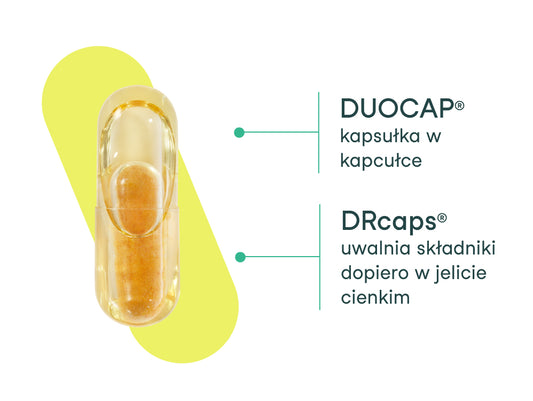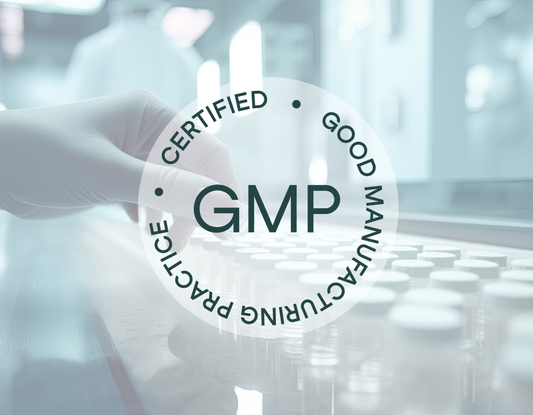
As we age, the body absorbs nutrients less easily. But he needs more of them. Wise nutrition and selected supplementation with well-digestible ingredients will allow you to feel and look healthy for as long as possible. Check what supplements to add to your diet.
Each stage in a woman's life differs in terms of her body's needs . They are shaped by changes related to age and hormones, as well as our responsibilities (at work, at home or in the family). In addition, diseases may add to this, taking away your energy and mood and affecting your appearance. The older we are, the more we must pay attention to what we eat to provide our body with all the necessary ingredients. This will help you minimize the risk of many diseases, support your health, mood and beauty, and give you the strength to face everyday challenges.
Changes in a woman's body that occur after the age of 50.
As we age, we move less and less. The amount of muscle mass in the body decreases and the number of fat cells increases 1 . Metabolic processes are also inhibited . The body breaks down nutrients slower and slower to obtain energy from them 2 . This means we need fewer calories and need to reduce our portion sizes (or exercise a lot more if we don't want to gain weight). The body's sensitivity to insulin also decreases 3 . This promotes weight gain. Menopause and the associated hormonal changes also lead to the accumulation of fat in the abdominal area 4 . They also affect bone density - they become more brittle and lose calcium 5 . The digestive system is also going through a period of change. The stomach of mature people may secrete less hydrochloric acid , which negatively affects the absorption of nutrients - protein, vitamins and minerals 6 . The more diseases we have and the more medications we take, the worse we absorb the ingredients.
To slow down the changes mentioned above and avoid many problems, women over 50 should eat less, but healthier 7 . With age, the role of thoughtful supplementation also increases, because a mature body needs even more valuable nutrients. Especially if a woman wants to feel and look healthy for as long as possible. Not all ingredients can be obtained from food in sufficient quantities . For example, the recommended daily dose of vitamin D is contained in 20 eggs or 600g of mackerel.
The role of antioxidants after the age of 50 .
Many scientific studies confirm that with age, the number of so-called free radicals in our body increases . There is also a theory that they are the main cause of aging 8 . Free radicals are reactive oxygen molecules. If too many of them accumulate, they can damage DNA structures, increasing the risk of cancer and other diseases 9,10 . To neutralize the effects of free radicals, the body needs antioxidants . It can produce them on its own and obtain them from food. If we want to slow down the aging process of the body and help prevent diseases caused by free radicals, we can help by supplementing with antioxidants.
Coenzyme Q10.
A good choice will be coenzyme Q10, which our body produces itself, but this production decreases more and more with age 11 . It is mainly known as an ingredient in facial creams because it improves the smoothness of the skin and reduces the visibility of wrinkles. However, research shows that its supplementation inhibits the body's aging processes at many levels 12,13,14,15 . It also has a beneficial effect on heart health, regulates blood pressure and helps reduce the risk of death from cardiovascular diseases 16,17,18,19 . It also supports the functioning of the pancreas and prevents the development of diabetes 20.21 . In addition, it may be helpful in relieving migraine symptoms 22.23 . It is an ingredient that participates in the creation and storage of energy in the cells of our body, and also protects them against destruction 24 .
Vitamin A.
Vitamins A and E will also delay the aging processes in the body, acting synergistically with coenzyme Q10. Vitamin A helps maintain eye health and good vision , which often deteriorates with age. Vitamin A is a component of the photosensitive pigment of the retina25 . It also helps regenerate tissues, including mucous membranes and skin 26 . It supports the immune system , the natural mechanisms of which weaken after the age of 50 27,28 . It is also helpful in preventing anemia 29 .
Vitamin E.
Another "vitamin of youth", the supplementation of which has tangible health benefits, is E. It helps protect brain health and prevent neurodegenerative diseases 30,31 . It supports immunity in mature people 32 , fights oxidative stress 33,34 , inflammation 35 , and protects against skin cell destruction 36 .
Bone health after the age of 50.
After the age of 50, the risk of bone brittleness in women increases significantly . During perimenopause, the loss of their density is caused by the decline in estrogen levels in the body. This process accelerates approximately 1 year before menopause and continues for the next 3 years. After that, the rate of calcium loss from the bones slows down a bit, but this continues for up to 8 years 37 . Of course, if menopause in a woman's life occurs earlier than the age of 50, we must take into account that unwanted changes in the bone structure will also begin earlier if we do not start counteracting them.
What every mature woman can do, without waiting for a doctor's visit, is supplementation with vitamins D and K. They have a proven effect on slowing down the development of osteoporosis 38,39 . Vitamin D3 regulates the body's absorption and use of calcium and phosphorus . Vitamin K2, on the other hand, allows minerals to be directed to the bones instead of the veins. It also supports proper blood clotting and helps prevent heart attack or stroke 40,41 . Research indicates that people with low levels of vitamin K in their blood had an approximately 19% greater risk of death from various causes 42 .
Vitamin K
Can't vitamin K be supplemented with diet? There are several types of this vitamin. Vitamin K1 can be found in vegetables - green and leafy. However, they must be consumed in large quantities, because K1 is only absorbed in approximately 5-10% 43 . Vitamin K2 is found in meat and fermented foods, but in small amounts. It is also produced by intestinal bacteria 44 . As we age, their amount in our body decreases, which means we receive less and less of this vitamin. Vitamin K1 is absorbed by the liver, while vitamin K2 is used throughout the body 45 , including in the bones. If we want to prevent osteoporosis, we need to look for a vitamin K2 supplement.
Vitamin D3.
We also cannot supplement vitamin D from our diet . It is also difficult to get enough of it from the sun. The older we get, the thinner our skin becomes . It is less and less able to produce vitamin D 46 . In Poland, as many as 90% of people may lack it 47 . It has a wide spectrum of effects on our body, not only regulating the health of bones and joints. It also supports immunity 48 , which functions worse with age and has anti-inflammatory properties . Supports the prevention of autoimmune diseases . It also helps maintain eye health and protect against macular degeneration in postmenopausal women 49 . Low levels of vitamin D are associated with depression, low mood , and worse brain functioning in mature people 50,51 . Deficiency of the "sunshine vitamin" also increases the risk of Parkinson's disease and multiple sclerosis 52,53,54,55 .
Omega-3 acids for women over 50.
Omega-3 acids , mistakenly associated mainly with fish, are an ingredient that is difficult to supplement from food. Their recommended dose is eaten by less than 20% of the global population 56 . Their importance increases even more with age, as they have a beneficial effect on the prevention of diseases typical of mature people. They help maintain heart and vascular health 57,58 and regulate triglyceride levels , reducing the risk of stroke 59,60 . Omega-3 acids support the immune system and contribute to the fight against viruses 61 and inflammation 62,63 , the level of which naturally increases with age in the body. Their high concentration in the body helps reduce the risk of cancer (e.g. colon 64 , breast cancer 65 ) and neurodegenerative diseases , as well as keeping the brain functioning efficiently for longer. 66,67,68 . Omega-3 acids (EPA + DHA) have a beneficial effect on eye health 69 , skin condition 70 and sleep quality 71 . Their deficiency is associated with depression and low mood 72,73,74 . When choosing a dietary supplement with Omega-3 fatty acids, it is worth making sure that they contain both DHA and EPA acids . Both types are important to our health.
Vitamins B4, B9 and B12 for a mature woman.
The benefits of B vitamins on the nervous system and blood formation are widely known. Many people choose supplementation with B vitamin complexes, thinking that it is the most convenient solution. However, when taking a complex of all or many vitamins from this group, we risk overdosing on some substances. In excess, they can lead to nausea and vomiting, cause allergies and even damage nerve cells and the liver75,76 . It is also important to choose active forms of these vitamins, which the body does not need to metabolize and can use immediately.
Choline.
Existing scientific evidence shows the health benefits of supplementing some B vitamins. For example, vitamin B4, or choline . Up to 90% of people may lack it 77 . It is part of every cell of the human body. It is important at every stage of a woman's life. Supports the liver in digesting fats 78 , protects the circulatory system 79 . It also supports memory and other cognitive functions80 .
Active folic acid (folates).
Another important vitamin – B9, commonly known as folic acid . In its active form, it is a valuable ally for women over 50. It helps reduce the feeling of fatigue, supports cognitive functions and delays brain aging 81 . Helps the cells of the immune system 82 , participates in blood production , protects against thrombosis, atherosclerosis, as well as heart attack and stroke 83,84,85,86 . However, traditional folic acid may not be absorbed by as many as 60% of people, which you can read more about here . Its most bioavailable form available on the market is Quatrefolic.
Vitamin B12.
Equally important, although less known, is vitamin B12 . Its benefits to the body include participation in blood production 87,88 , assistance in maintaining an optimal lipid profile 89,90 , support for immunity 91 and brain function 92 , as well as energy levels during the day 93 . Vitamin B12 regulates sleep and circadian rhythms 94,95 . It helps the nervous system and can improve mood and well-being , including in people struggling with depression 96,97 . Active vitamin B12, naturally occurring in the body, can be found in dietary supplements in the form of methylcobalamin and adenosinecobalamin .

The quality of dietary supplements becomes even more important with age.
Due to the fact that older people absorb ingredients from supplements less easily, it is worth paying special attention to the form of active substances . We have already mentioned that most of us simply cannot absorb "traditional" folic acid. The situation may be similar with vitamin B12 in its inactive form (i.e. cyanocobalamin). Equally important is the origin of the individual ingredients of a dietary supplement, as well as the conditions in which it was produced. These and other factors determine whether supplementation will work and whether it will be safe. If you want to find out what to watch out for before purchasing any dietary supplement, please click here.
Bibliography:
- Shimokata H, Kuzuya F. [Aging, basal metabolic rate, and nutrition]. Nihon Ronen Igakkai Zasshi. 1993 Jul;30(7):572-6. Japanese.
- “Minding Your Metabolism,” National Institutes of Health, part of the US Department of Health and Human Services, July 2015.
- Mathus-Vliegen EM. Obesity and the elderly. J Clin Gastroenterol. 2012.
- Davis SR, Castelo-Branco C, Chedraui P, Lumsden MA, Nappi RE, Shah D, Villaseca P; Writing Group of the International Menopause Society for World Menopause Day 2012. Understanding weight gain at menopause. Climacteric. 2012 Oct;15(5):419-29.
- Wołczyński S., Kita K., Sierakowski S., Lewandowski B., "Estrogens and SERMS in the prevention and treatment of postmenopausal osteoporosis." Borgis - Nowa Medycyna 3/2004.
- Robert M. Russell, Factors in Aging that Effect the Bioavailability of Nutrients, The Journal of Nutrition, Volume 131, Issue 4, April 2001, Pages 1359S–1361S.
- Institute of Medicine (US) Food Forum. Providing Healthy and Safe Foods As We Age: Workshop Summary. Washington (DC): National Academies Press (US); 2010. 5, Nutrition Concerns for Aging Populations.
- Harman D. Free radical theory of aging: an update: increasing the functional life span. Ann NY Acad Sci. 2006 May;1067:10-21.
- Singh AK, Pandey P, Tewari M, Pandey HP, Gambhir IS, Shukla HS. Free radicals hasten head and neck cancer risk: A study of total oxidant, total antioxidant, DNA damage, and histological grade. J Postgrad Med. 2016;62(2):96-101.
- Liguori I, Russo G, Curcio F, et al. Oxidative stress, aging, and diseases. Clin Interv Aging. 2018;13:757-772. Published 2018 Apr 26.
- Barcelos IP, Haas RH. CoQ10 and Aging. Biology (Basel). 2019;8(2):28. Published 2019 May 11.
- Richard Morrill. Antiaging, Antioxidant function, Cardiovascular Health, Healthy People. May 2, 2017. Coenzyme Q10 and healthy aging.
- John Alexander. Antiaging. June 18, 2021. Coenzyme Q10 Supplementation in Aging and Disease.
- Hernández-Camacho JD, Bernier M., López-Lluch G., Navas P., “Coenzyme Q10 Supplementation in Aging and Disease.” Front Physiol, 2018.
- Juan Garrido-Maraver et al. Front Biosci (Landmark Ed). 2014 Jan 1;19:619-33. Clinical applications of coenzyme Q10.
- Salvatore Pepe et al. Mitochondrion. 2007 Jun;7 Suppl:S154-67. Coenzyme Q10 in cardiovascular disease.
- James J DiNicolantonio et al. OpenHeart. 2015 Oct 19;2(1):e000326. Coenzyme Q10 for the treatment of heart failure: a review of the literature.
- Svend A Mortensen et al. JACC Heart Fail. 2014 Dec;2(6):641-9. The effect of coenzyme Q10 on morbidity and mortality in chronic heart failure: results from Q-SYMBIO: a randomized double-blind trial.
- C Morisco et al. Clin Investig. 1993;71(8 Suppl):S134-6. Effect of coenzyme Q10 therapy in patients with congestive heart failure: a long-term multicenter randomized study.
- Eman A El-ghoroury et al. Blood Coagul Fibrinolysis. 2009 Jun;20(4):248-51. Malondialdehyde and coenzyme Q10 in platelets and serum in type 2 diabetes mellitus: correlation with glycemic control.
- Hoda Zahedi et al. J Diabetes Metab Disord. 2014 Jul 25;13:81. Effects of CoQ10 Supplementation on Lipid Profiles and Glycemic Control in Patients with Type 2 Diabetes: a randomized, double blind, placebo-controlled trial.
- Mohammad Parohan et al. Nutr Neurosci. 2020 Nov;23(11):868-875. Effect of coenzyme Q10 supplementation on clinical features of migraine: a systematic review and dose-response meta-analysis of randomized controlled trials.
- P. S. Sándor et al. Neurology. 2005 Feb 22;64(4):713-5. Efficacy of coenzyme Q10 in migraine prophylaxis: a randomized controlled trial.
- Galluzzi L, Kepp O, Trojel-Hansen C, Kroemer G. Mitochondrial control of cellular life, stress, and death. Circ Res. 2012 Oct 12;111(9):1198-207.
- Saari JC, “Vitamin A and Vision”. Subcell Biochem. 2016.
- EFSA Journal 2009; 7(9):1221. Scientific Opinion on the substance of health claims related to vitamin A.
- J Rodrigo Mora et al. Nat Rev Immunol. 2008 Sep;8(9):685-98. Vitamin effects on the immune system: vitamins A and D take center stage.
- Mora J., Iwata M., von Andrian U., “Vitamin effects on the immune system: vitamins A and D take center stage.” Nat Rev Immunol 8, 2008.
- EFSA Journal 2009; 7(9):1221. Scientific Opinion on the substance of health claims related to vitamin A.
- Martha Clare Morris et al. Arch Neurol. 2002 Jul;59(7):1125-32. Vitamin E and cognitive decline in older persons.
- Giorgio La Fata,* Peter Weber, and M. Hasan Mohajeri. Nutrients. 2014 Dec; 6(12): 5453–5472. Published online 2014 Nov 28. Effects of Vitamin E on Cognitive Performance during Aging and in Alzheimer's Disease.
- Ga Young Lee and Sung Nim Han. Nutrients. 2018 Nov; 10(11): 1614. Published online 2018 Nov 1. The Role of Vitamin E in Immunity.
- Chung-Yung Jetty Lee, Fan Wan. The Journal of Nutrition, Volume 130, Issue 12, December 2000, Pages 2932–2937. Vitamin E Supplementation Improves Cell-Mediated Immunity and Oxidative Stress of Asian Men and Women.
- Mohsen Meydani DVM, Ph.D. SpringerLink. Published: July 1992. Protective role of dietary vitamin E on oxidative stress in aging.
- U Singh, S Devaraj, I Jialal. Annu Rev Nutr. 2005;25:151-74. Vitamin E, oxidative stress, and inflammation.
- Packer L., Valacchi G., "Antioxidants and the response of skin to oxidative stress: vitamin E as a key indicator". Skin Pharmacol Appl Skin Physiol. 2002 Sep-Oct;15(5).
- Greendale GA, Sowers M, Han W, Huang MH, Finkelstein JS, Crandall CJ, Lee JS, Karlamangla AS. Bone mineral density loss in relation to the final menstrual period in a multiethnic cohort: results from the Study of Women's Health Across the Nation (SWAN). J Bone Miner Res. 2012 Jan;27(1):111-8.
- Laird E., Ward M., McSorley E., Strain JJ, Wallace J., “Vitamin D and bone health: potential mechanisms.” Nutrients. 2010
- Capozzi A., Scambia G., Migliaccio S., Lello S., “Role of vitamin K2 in bone metabolism: a point of view and a brief reappraisal of the literature.” Gynecol Endocrinol. 2020
- J. van Ballegooijen and J. W. Beulens. Curr Nutr Rep. 2017; 6(3): 197–205.Published online 2017 Jul 10. The Role of Vitamin K Status in Cardiovascular Health: Evidence from Observational and Clinical Studies.
- Jamie W Bellinge et al. J Am Heart Assoc. 2021 Aug 17;10(16):e020551. Vitamin K Intake and Atherosclerotic Cardiovascular Disease in the Danish Diet Cancer and Health Study.
- M Kyla Shea, Kathryn Barger, Sarah L Booth, Gregory Matuszek, Mary Cushman, Emelia J Benjamin, Stephen B Kritchevsky, Daniel E Weiner, Vitamin K status, cardiovascular disease, and all-cause mortality: a participant-level meta-analysis of 3 US cohorts, The American Journal of Clinical Nutrition, Volume 111, Issue 6, June 2020, Pages 1170–1177.
- Popa DS, Bigman G, Rusu ME. The Role of Vitamin K in Humans: Implication in Aging and Age-Associated Diseases. Antioxidants (Basel). 2021;10(4):566. Published 2021 Apr 6.
- Wagatsuma K, Yamada S, Ao M, et al. Diversity of Gut Microbiota Affecting Serum Level of Undercarboxylated Osteocalcin in Patients with Crohn's Disease. Nutrients. 2019;11(7):1541. Published 2019 Jul 8.
- “Vitamin K1 vs K2: what you should know”, Naturalmedicines.therapeuticresearch.com, May 2019
- Mostafa WZ, Hegazy RA. Vitamin D and the skin: Focus on a complex relationship: A review. J Adv Res. 2015;6(6):793-804.
- Agnieszka Rusińska et al. Front Endocrinol (Lausanne). 2018 May 31;9:246. Vitamin D Supplementation Guidelines for General Population and Groups at Risk of Vitamin D Deficiency in Poland-Recommendations of the Polish Society of Pediatric Endocrinology and Diabetes and the Expert Panel With Participation of National Specialist Consultants and Representatives of Scientific Societies.
- EFSA Journal 2015;13(5):4096. Scientific Opinion on the substance of a health claim related to vitamin D and contribution to the normal function of the immune system.
- Amy E Millen et al., CAREDS Study Group. Arch Ophthalmol. 2011 Apr;129(4):481-9. Vitamin D status and early age-related macular degeneration in postmenopausal women.
- Consuelo H Wilkins et al. Am J Geriatr Psychiatry. 2006 Dec;14(12):1032-40. Vitamin D deficiency is associated with low mood and worse cognitive performance in older adults.
- R Jorde et al. Randomized Controlled Trial J Intern Med. 2008 Dec;264(6):599-609. Effects of vitamin D supplementation on symptoms of depression in overweight and obese subjects: randomized double blind trial.
- Jennifer S. Buell, MS and Bess Dawson-Hughes, MD. Mol Aspects Med. 2008 Dec; 29(6): 415–422. Published online 2008 May 13. Vitamin D and Neurocognitive Dysfunction: Preventing “D”ecline?
- David J Llewellyn et al. Arch Intern Med. 2010 Jul 12;170(13):1135-41. Vitamin D and risk of cognitive decline in elderly persons.
- Paul Knekt et al. Arch Neurol. 2010 Jul;67(7):808-11. Vitamin D serum and the risk of Parkinson disease.
- Kassandra L Munger et al. CAVITY. 2006 Dec 20;296(23):2832-8. Serum 25-hydroxyvitamin D levels and risk of multiple sclerosis.
- Ken D. Stark et al. Elsevier. Progress in Lipid Research. Volume 63, July 2016. Global survey of the omega-3 fatty acids, docosahexaenoic acid and eicosapentaenoic acid in the blood stream of healthy adults.
- EFSA Journal 2010;8(10):1796. Scientific Opinion on the substance of health claims related to eicosapentaenoic acid (EPA), docosahexaenoic acid (DHA), docosapentaenoic acid (DPA).
- SoumiaPeter et al. Endocrinol Metab. 2013 May-Jun; 17(3): 422–429. A fish a day keeps the cardiologist away! – A review of the effect of omega-3 fatty acids in the cardiovascular system.
- Ann C. Skulas-Ray et al. Circulation. 2019 Sep 17;140(12):e673-e691. Omega-3 Fatty Acids for the Management of Hypertriglyceridemia: A Science Advisory From the American Heart Association.
- Tahreem Iqbal, Michael Miller. Curr Cardiol Rep. 2021 Jul 11;23(8):111. A Fishy Topic: VITAL, REDUCE-IT, STRENGTH, and Beyond: Putting Omega-3 Fatty Acids into Practice in 2021.
- Calder, P. C. et al. Optimal Nutritional Status for a Well-Functioning Immune System Is an Important Factor to Protect against Viral Infections. Nutrients., vol. 12 no. 1181, 2020.
- Gutierrez S et al. Effects of omega-3 fatty acids on immune cells. Intl J Mol Sci., vol. 20, no. 20, pg. 5028, 2019.
- Basil MC and Levy BD. Specialized pro-resolving mediators: endogenous regulators of infection and inflammation. Nature Reviews | Immunology, vol. 16, pg. 51-67, 2016.
- Evropi Theodoratou et al. Am J Epidemiol. 2007 Jul 15;166(2):181-95. Dietary fatty acids and colorectal cancer: a case-control study.
- Carol J Fabian et al. Breast Cancer Research. Published: 04 May 2015. Omega-3 fatty acids for breast cancer prevention and survivorship.
- Majid Fotuhi et al. Review Nat Clin Pract Neurol. 2009 Mar;5(3):140-52. Fish consumption, long-chain omega-3 fatty acids and risk of cognitive decline or Alzheimer disease: a complex association.
- Ernst J Schaefer at al. Arch Neurol. 2006 Nov;63(11):1545-50. Plasma phosphatidylcholine docosahexaenoic acid content and risk of dementia and Alzheimer disease: the Framingham Heart Study.
- Karin Yurko-Mauro et al. Alzheimer's Dementia. 2010 Nov;6(6):456-64. Beneficial effects of docosahexaenoic acid on cognition in age-related cognitive decline.
- Tulay Cakiner-Egilmez. Insight. Oct-Dec 2008;33(4):20-5; quiz 26-7. Omega 3 fatty acids and the eye.
- Anamaria Balić et al. Int J Mol Sci. 2020 Feb; 21(3): 741. Published online 2020 Jan 23. Omega-3 Versus Omega-6 Polyunsaturated Fatty Acids in the Prevention and Treatment of Inflammatory Skin Diseases.
- Del Brutto et al. Dietary fish intake and sleep quality: a population-based study. Sleep Med., vol. 17, pg. 126-128, 2016.
- Pao-Yen et al. Are omega-3 fatty acids antidepressants or just mood-improving agents? The effect depends upon diagnosis, supplement preparation and severity of depression. Molecular Psychiatry, vol. 17, pg. 1161-1163, 2012.
- Mischoulon D. Omega-3 fatty acids for mood disorders.
- Robert K, McNamara, Ph.D. J Nutr Intermed Metab. 2016 Sep; 5: 96–106. Published online 2016 May 4. Role of Omega-3 Fatty Acids in the Etiology, Treatment, and Prevention of Depression: Current Status and Future Directions.
- Ellsworth MA, Anderson KR, Hall DJ, Freese DK, Lloyd RM, "Acute liver failure secondary to niacin toxicity." Case Rep Pediatr. 2014
- Vrolijk MF, Opperhuizen A., Jansen EHJM et al., “The vitamin B6 paradox: Supplementation with high concentrations of pyridoxine leads to decreased vitamin B6 function.” Toxicol In Vitro. 2017
- Vaneeghen Functional Ingredients, VitaCholine, 2021.
- EFSA Journal 2011;9(4):2056. Scientific Opinion on the substance of health claims related to choline and contribution to normal lipid metabolism, maintenance of normal liver function, contribution to normal homocysteine metabolism, maintenance of normal neurological function, contribution to normal cognitive function, and brain and neurological development.
- Heather R. Millard et al. Protection against atherosclerosis, heart attacks and strokes. Eur J Nutr. 2018 Feb;57(1):51-60. Dietary choline and betaine; associations with subclinical markers of cardiovascular disease risk and incidence of CVD, coronary heart disease and stroke: the Jackson Heart Study.
- Derbyshire E., Obeid R.,”Choline.Neurological Development and Brain Function: A Systematic Review Focusing on the First 1000 Days.” Nutrients, June 2020.
- Fei Ma et al.. Sci Rep. 2016; 6: 37486. Published online 2016 Nov 23. Folic acid supplementation improves cognitive function by reducing the levels of peripheral inflammatory cytokines in elderly Chinese subjects with MCI.
- Catherine J Field et al. J Nutr Biochem. 2006 Jan;17(1):37-44. Dietary folate improves age-related decreases in lymphocyte function.
- Charalambos Antoniades et al. Circulation. 2006 Sep 12;114(11):1193-201. 5-methyltetrahydrofolate rapidly improves endothelial function and decreases superoxide production in human vessels: effects on vascular tetrahydrobiopterin availability and endothelial nitric oxide synthase coupling.
- Yuan Wang et al. Medicine (Baltimore). 2019 Sep; 98(37): e17095. Published online 2019 Sep 13. The effect of folic acid in patients with cardiovascular disease. A systematic review and meta-analysis.
- S. N. Doshi et al. Clinical Trial Arterioscler Thromb Vasc Biol. 2001 Jul;21(7):1196-202. Folate improves endothelial function in coronary artery disease: an effect mediated by reduction of intracellular superoxide?
- Tao Tian et al. Am J Med Sci. 2017 Oct;354(4):379-387. Folic Acid Supplementation for Stroke Prevention in Patients With Cardiovascular Disease.
- EFSA Journal 2010;8(10):1756. Scientific Opinion on the substance of health claims related to vitamin B12 and contribution to normal neurological and psychological functions, contribution to normal homocysteine metabolism, maintenance of normal bone, maintenance of normal teeth, maintenance of normal hair, maintenance of normal skin, maintenance of normal nails, reduction of tiredness and fatigue, and cell division.
- Jarosław Krzywański et al. Nutrients. 2020 Apr 9;12(4):1038. Vitamin B 12 Status and Optimal Range for Hemoglobin Formation in Elite Athletes.
- Antonysunil Adaikalakoteswari et al. Published: 26 September 2014. Vitamin B12 deficiency is associated with adverse lipid profile in Europeans and Indians with type 2 diabetes. Cardiovascular Diabetology volume 13.
- Antonysunil Adaikalakoteswari et al. Clin Epigenetics. 2015; 7(1): 14. Published online 2015 Feb 27. Vitamin B12 insufficiency induces cholesterol biosynthesis by limiting s-adenosylmethionine and modulating the methylation of SREBF1 and LDLR genes.
- J Tamura et al. Clin Exp Immunol. 1999 Apr;116(1):28-32. Immunomodulation by vitamin B12: augmentation of CD8+ T lymphocytes and natural killer (NK) cell activity in vitamin B12-deficient patients by methyl-B12 treatment.
- Theresa Köbe at al. Am J Clin Nutr. 2016 Apr;103(4):1045-54. Epub 2016 Feb 24. Vitamin B-12 concentration, memory performance, and hippocampal structure in patients with mild cognitive impairment.
- Theresa Köbe at al. Am J Clin Nutr. 2016 Apr;103(4):1045-54. Epub 2016 Feb 24. Vitamin B-12 concentration, memory performance, and hippocampal structure in patients with mild cognitive impairment.
- G Mayer, M Kröger, K Meier-Ewert. Neuropsychopharmacology. 1996 Nov;15(5):456-64. Effects of vitamin B12 on performance and circadian rhythm in normal subjects.
- M Okawa et al. Sleep. 1990 Feb;13(1):15-23. Vitamin B12 treatment for sleep-wake rhythm disorders.
- Leishear, K et al. (2012). Relationship between vitamin B 12 and sensory and motor peripheral nerve function in older adults. Journal of the American Geriatrics Society, 60(6), 1057-1063.
- Syed, E. U., Wasay, M., & Awan, S. (2013). The open neurology journal, 7, 44. Vitamin B12 supplementation in treating major depressive disorder: a randomized controlled trial.


What makes our capsule stand out?
The nikalab capsule impresses not only with its appearance, but also with its operation. We used two innovative...








